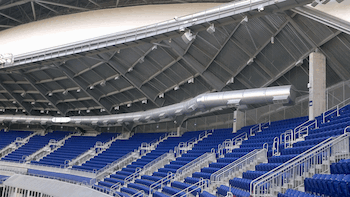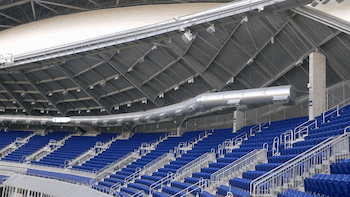Whitinsville, MA--The Miami Marlins (formerly the Florida Marlins) squared off against the World Champion St. Louis Cardinals on April 4, 2012, inaugurating a new season of baseball and christening the newest page in the history of baseball stadiums.

At a cost of $515 million and sited on 17 acres in the Little Havana neighborhood of Miami, Marlins Park is everything you might expect from a South Florida sports venue – lime-green outfield walls, palm trees, pink flamingos, sea gulls and smiling marlin avatars activated when a Marlin player belts a home run. And when Jose Feliciano sang the national anthem there for the first time that Wednesday afternoon, the opening-day crowd of 36,601 heard every word crisply and clearly thanks to a new sound system using components from loudspeaker manufacturer Eastern Acoustic Works (EAW).
Using a total of 517 EAW MK, QX and MQX series loudspeakers around the bowl in a massive distributed system designed by Wrightson, Johnson, Haddon & Williams (WJHW) and installed by Minneapolis-based systems integrator Parsons Electric, the EAW system was able to address a unique and challenging architectural issue. Marlins Park has a retractable roof, but in order to best take advantage of the sun for its natural-grass field, the stadium had to be angled in such a way that the grass get as much exposure to the sun as possible between games.
As a result, rather than the usual half-dozen or so section templates in the seating areas for which a basic configuration of speakers would make up a repeatable pattern, this system’s design required over 30 individual section drawings, with nearly every one of the upper-deck sections being unique. Thus, speaker placement and aiming was different for virtually every location on the upper deck. In all, the 517 speakers were grouped into 23 categories, in some cases with multiple EAW speakers used to cover a single area.
In addition, the stadium’s asymmetrical design meant that focal points often needed different throw-length speakers set at different distances and patterns. For instance, the area around home plate uses the EAW MQX8343-MS-WP long-throw enclosure from one side, but is matched on the baseline sides and outfield porch by a shorter-throw QX564-WP unit.
“The system design was very complex, but the EAW speakers were exactly what we needed to make it work,” said Tim Habedank, systems specialist at Parsons Electric. “On opening day, the sound was clear and highly intelligible, even over the noise of a capacity crowd.”
Habedank adds that while the roof is likely to be closed for most events at the stadium, the long reverb time when it is closed, particularly in the lower frequencies, will remain under complete control, thanks to the precise aiming pattern that the EAW speakers are capable of. “We were able to achieve very tight pattern control across the spectrum,” he said. “Yet at the same time the longest-throw speakers maintain the coherence of the sound for distances of between 200 and 300 feet. It’s really remarkable performance and the sound of the stadium shows it.”











